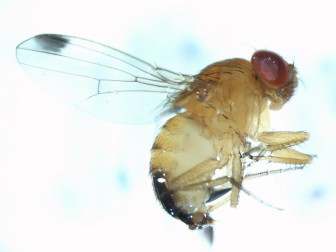
The spotted winged drosophila uses its sharp incisor to lay her eggs in your favorite fruit. Image: Bob Koch, Minnesota Department of Agriculture.
By Kayla Smith
Researchers are scrambling to stop the spread of an invasive fruit fly before it decimates Midwest fruit markets.
“I think we have a big challenge on our hands,” said Joan Donaldson who with her husband, Jon, runs the Pleasant Hill Organic Blueberry Farm in Fennville, Michigan.
The only pesticides Pleasant Hill uses are “like a yogurt culture,” said Donaldson, who is working with a Michigan State University Extension program to combat the bug.
Pleasant Hill Farms has been in the family since 1937, and although they also sell strawberries, peaches and a few canned goods, their livelihood relies on the health of their blueberries Donaldson said.
“If you don’t manage them, you will have 100 percent crop loss,” said Christelle Guedot, a University of Madison-Wisconsin entomologist who has been in the forefront of the fight since it began. “Maybe not right away, but it will quickly result in 100 percent crop loss.”
Wisconsin and Michigan reported an infestation of spotted winged drosophila in 2012.
The U.S. Department of Agriculture has backed a multi-state study of the pest and management strategies such as pesticide control.
This insect has a meaner bite than the traditional fruit fly. It came from Japan and invaded California in 2008. The Pacific west coast has since lost $420 million in fruit profits to the fly’s voracious appetite, according to a 2012 report by Michigan State University entomologist Rufus Isaacs.
The fly cuts into the flesh of living fruit and plants its eggs. As the larvae grow, the fruit rots. The species quickly reproduces, heightening its threat to crops, Isaacs reported.
In Wisconsin, raspberry crops have been hit the hardest, but each state has its own weak points and many farmers are choosing to cut their losses, Guédot said.
“The bottom line is that growers will completely give up, because they can’t afford the intensive management strategies,” she said.
A majority of the fruit growers Guédot and her team work with have multi-crop operations, meaning they may have a strawberry patch, an apple orchard and a blueberry crop on one farm. These types of farms can lose the crop with the highest risk of infestation and invest in other, hardier fruit. This alternative form of management is a form of cultural control.
You-pick berry farms all over the Great Lakes region are threatened by the invasive fly, Guedot said. Farms have to invest in expensive insecticide programs to prevent infestation or they lose an entire crop.
Regulated pesticides kill only adult flies, Guédot said.
The only protections against larva infestation are cultural controls. This type of management involves cleaning up infested fruit, harvesting quickly and getting rid of nearby food sources like blackberries, dogwoods and honeysuckle, according to the University of Madison-Wisconsin’s Russell Labs.
Organic farms are particularly vulnerable as they can’t use pesticides.
U.S. Department of Agriculture funding for invasive fly research programs keeps Donaldson’s hopes lifted.
“There’s many minds working on the problem, and we’re very fortunate,” she said.
The more information researchers learn about the insect, the faster control methods can be developed, said Guédot.
Places like Pleasant Hill Farms say they hope control methods come around quickly. Even organic pesticides cost $800 per treatment, said Donaldson.
Michigan State University has more information on the spotted winged drosophila.